Neil Taylor, Strike Three Kayak Fishing
“The whole picture”: Being better at using lures
There are some very simple guidelines to become more proficient with using lures successfully. “Kayak Fishing Skool” themes are almost entirely in support of this undertaking. The whole thing comes down to: Can you move the lure where it looks like something that they want to eat? As a guide who uses lures 99.9% of the time I can tell you that if you develop the confidence, you will have no need to ever bait a hook again.
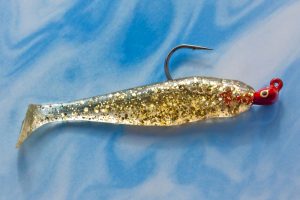
The Kayak Angler is a good example. Most people go this direction eventually, especially if the kayak is the chosen method of transportation: Get rid of the live bait and go to lures. A step up in the fishing evolution, the final decision is whether to pick up fly fishing, which is the ultimate challenge.
Lures work. Lures are way more fun to use than natural baits. Like it or not, you get more out of being responsible for the strike than watching a rod in a rod holder waiting for a bait to be “eaten.” The last time I baited a hook for a client? August of 2013. It is your choice how you do it. If you are like me, you want to keep things as simple as you possibly can.
Use lures and methods you have confidence in
Using the lures you know have worked very well for you in the past, you can get aggressive and go after the fish with more intensity. Learn to work lures at a very slow speed. There are times when the fish are there and will feed but will only do so if you’re working your lure at a “crawl speed.” They may be down there and willing to feed but have no desire to exert any energy to charge after a lure.
Modify the speed until you get them to eat the lure. Movement of the lure should be realistic, regardless of the speed you’re moving it through the water. I call this “pace.” The right pace should always have the lure moving realistically but right down near the bottom. That is where fish live. That is where fish feed. It increases the odds on getting a strike. “Pace” is all about moving a lure within four inches of the bottom whether you are in 12 feet of water. Or 12 inches.
My first choice:
12 Fathom Lures: 3 inch mullet, 5 inch SlamR and the Buzz Tail Shad
Mirrolure: Top Dog Jr., Top Pup and their new series the C-Eye Poppa Mullet.
The right rod. The wrong rod.
So many of the clients have their own gear. They book trips to get better at lures. Upon inspection I often have to tell them that they need to invest in better equipment. The key? The rod. The reel is just a device to retrieve the line. For using light lures in particular, a quality high modulus graphite rod is going to make all the difference. Those less desirable rods: Put topwater lures on those ones. Invest in the right rod for using the light lures. Spend the money, catch fish. My first choice: The St Croix Inshore Avid, Medium Power, Fast Action.
Technique
Most of you are “cast and reel” types. While that will work to a certain extent, you will not catch 50% of what I do. What is the difference? I am moving the lure with the rod tip. I am using the reel to pick up the line I bring toward me with the rod tip. The whole picture, see “Getting Control of your lure” below.
Proper Rigging
No matter what jighead choice you make, you want to feed the plastic tail on that jighead so that the lure is laying flat and straight. I inspect peoples’ equipment. People that have struggled to catch fish on lures, a really common theme with all of them: They don’t know how to properly rig a lure. In general, lures should be straight and lay mostly flat.
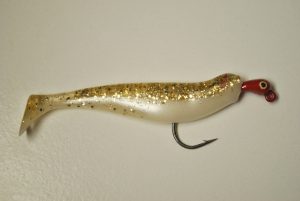
Casting
Strive to improve you casting abilities. Long, accurate casts are necessary in clear water conditions. Have your spools filled to the optimum level to add that extra few feet to your casting distance. The best anglers are usually those who master their casting. Longer casts allow an angler to work more water. Learning to get the lure on the move just after it enters the water also results in better results. Long casts win the game. The longest cast: Your lure is going through more water. Because of that, more fish see your lure. The more fish see your lure the more strikes you get. The more strikes you get the more fish you get hooked. The more you get hooked, the more you catch.
As an instructor, one of the biggest things I work on with people is their casting. My tricks to creating a better caster are all things that are fairly straightforward. It is good technique combined with the right “energy.” Energy is the speed in which you accelerate your lure forward during a cast.
Getting Control of your Lure
This is way more important than most people realize. The people who have mastered this are the better anglers. What exactly does it mean? Imagine this: When it is me, I have control of my lure from the time I make the cast until I have landed the fish. The trick is what you do when the lure is approaching “splashdown.”
Targeting your quarry
It’s often a “hunting” game with inshore fish. Fish won’t always be exactly where you expect them to be, though one may often find the fish there at specific times. Alertness and awareness come in to play but with hunting you will have a better Game Plan if you think it all through before you go. You will have areas that you’ll expect the fish to be. If you get there and they’re not there, look for evidence of baitfish nearby. Plan on where you’ll go to next if you don’t find the fish in that one particular location, minimizing travel distance as much as possible as you go point-to-point.
I’ll “take a swing” past secondary areas on the way to a really good location. I’ll usually move through those areas faster than I would a primary location. I’ll be intensely watching for clues. If I see a lot of bait or begin spooking out fish, I’ll stop there.
“Reading” the water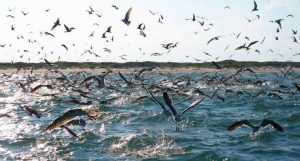
Watch and Listen for clues. Time and experience will help you to determine a difference between the sounds of a mullet splash and the “Pop” of a snook or other game fish. Identify the location of the violent splashes and move within casting distance of that spot as quickly as you possibly can.
“Read” off your visual clues. A dark shadow in the water could be a fish and not some other object. Lighter areas can indicate a sand “pothole”, a common place for fish to lay in wait, or they can indicate a depth change which is also a great area to try a cast.
Also, fish that are “on the move” will often push up wakes that are detectable by someone who spends a great deal of time on the water. It’s often a subtle ripple on the water but with polarized glasses and some experience, one should be able to start spotting these fish that are in transit to another location. Tiny baitfish will “shower” out of the water when a predatory fish is swimming toward them. The direction the baits are coming out of the water gives you the hint on the direction that fish is moving.
Find the baitfish
Go where the food is. The fish do. Baitfish, signs of startled baitfish, game fish feeding on baitfish, birds hovering or diving: These are all clues as to where predation will occur. Pelicans diving from higher up will indicate larger baits and often should be a focal point for making some casts.
Explosions, obviously feeding fish in those locations. Redfish tails waving in the shallows: Those fish are feeding.
Make mental notes on where you saw the fish, caught fish and what the tides were at that time. This will help you to form a game plan for future trips to that same area.
Making Adjustments
Coping with floating grass is part of the advantage. Cruising the lure in healthy turtle grass is the other. With a conventional jighead, it can be tough fishing in both situations. The Edje or other weedless jighead is a must-have.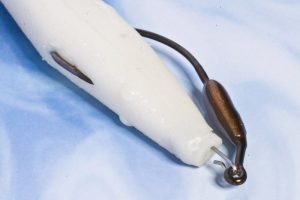
Choices in weedless jigheads, it also depends on which lure you are rigging. I would not recommend a paddletail such as the Mullet on The Edje. A standard jighead with a metal weed guard is a better choice. You want the point of the hook to expose on a strike, something that is not as likely with the screw lock choices and the thickness of the plastic on a paddletail.
Heat and sun “high in the sky”
Myth: Lures don’t catch fish in the summertime
Fact: Natural baits will work better in high in the sky sunlight hours. For fully ten months of the year, lures can compete. July and August, water temperatures near 90, natural baits will outperform lures. Targeting the coolest part of the day, fish can still be caught on lures but in daylight hours, lower oxygen and unhappy fish, they will be more willing to eat a natural bait lying motionless.
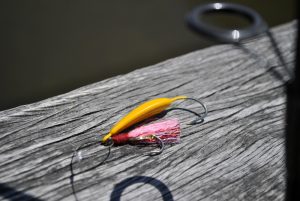
Going to one location in Florida my entire life, we had it written off as a live bait only situation. I go there nearly every summer. This past year I received some local knowledge. Talking to guys who lived there, I took a scissors to lures and thinned them out. I caught fish on lures for the first time, even though I had tried many other times in the past. More evidence lures work, you just sometimes have to know the “tricks.”
Always learn: From success and from mistakes
Sometimes the biggest missed opportunities are in the successes. In developing advanced technique, hooking a fish, most people ignore the opportunity to learn. That action on a lure got a strike, some thought and identification can help with developing exact technique. Personally I have 11 exact techniques I use for getting a redfish to eat a lure. Years of study in field research, I will catch redfish on days other people will not because I have the arsenal of techniques built up.
I call it the “mental check.” You are working the lure, you get a hookup. It could be a missed opportunity. Do you: Evaluate your technique? What was I doing when I got the strike?
If you are at that step in your fishing career and you want to become successful with lures, make it happen. Force yourself to use them. Pay attention to what works and enjoy the success.
Neil Taylor
“Instructional Kayak Fishing”
Strike Three Kayak Fishing
www.strikethreekayakfishing.com
(Cell) 727-692-6345
LivelyBaits@aol.com
Neil hosts Kayak Fishing Skool (fourth Thursday of every month, Bill Jackson’s); The Kayak Fishing Academy (a three hour tutorial, also at the store); Capmel.com Radio host; Writer and speaker for the Tampa Bay Times. Neil is a steward of the environment, founded Florida Anglers United and will be a beacon for change in Florida policymaking every year moving forward.
To get much better at using lures, book a trip with Neil. Learn the how and why to successfully using lures to catch fish. Learn the habits of the fish; tides and other factors that go into successful fishing trips.

- The Neil Blog… - July 26, 2023
- The Catfish - July 26, 2023
- update - July 22, 2023











